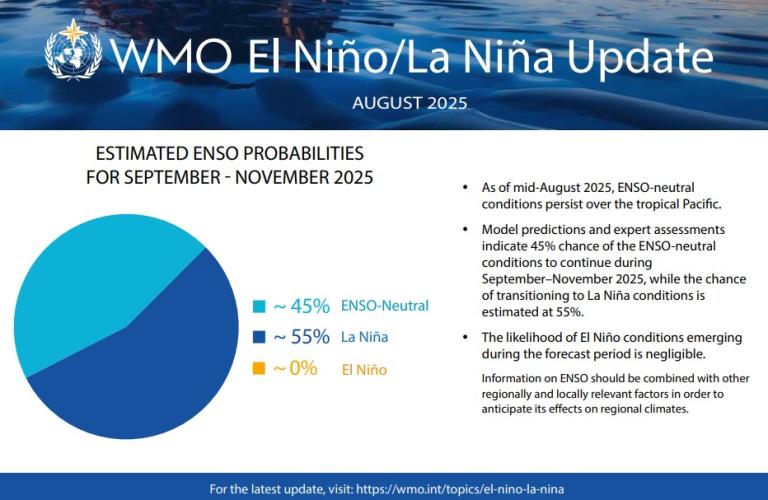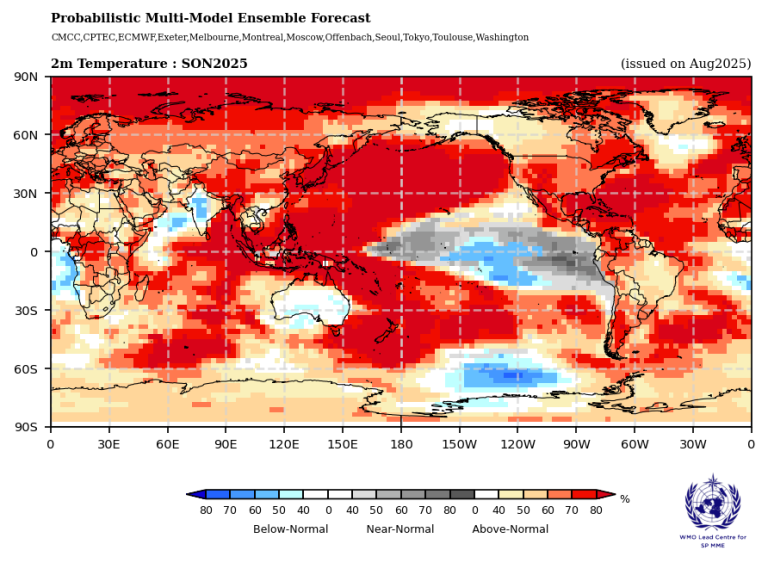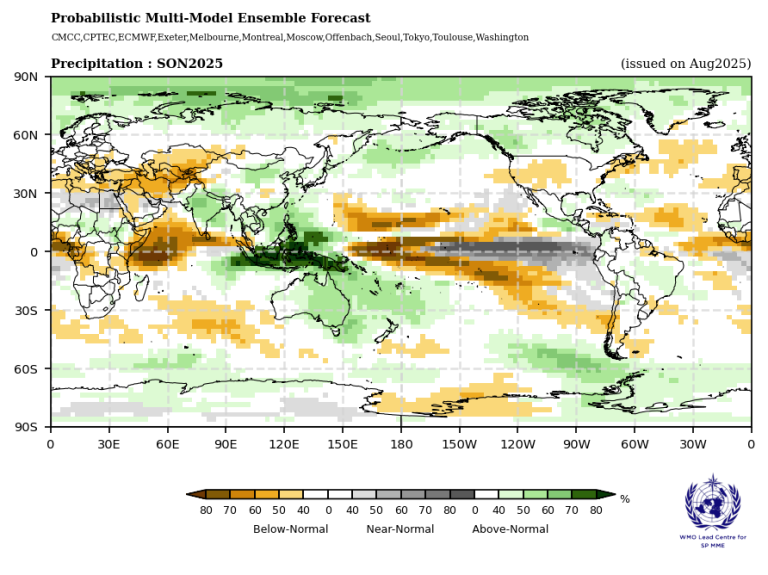La Niña may return but temperatures are likely to be above average
La Niña may return to impact weather and climate patterns from September onwards, according to the latest World Meteorological Organization (WMO) El Niño/La Niña update. But despite the temporary cooling influence of La Niña, temperatures are still expected to be above average for much of the world.
- El Niño Southern Oscillation (ENSO) neutral conditions have persisted since March 2025
- El Niño and La Niña affect climate patterns in different parts of world
- Seasonal forecasts inform decision makers in key economic sectors and help disaster risk management
- Global Seasonal Climate Update predicts widespread above average temperatures

Neutral conditions (neither El Niño or La Niña) have persisted since March 2025, with sea surface temperature anomalies remaining near average across the equatorial Pacific. However, these conditions may gradually make way for La Niña conditions to emerge in the coming months, potentially starting in September 2025.
According to the latest forecasts from the WMO Global Producing Centres for Seasonal Prediction, there is a 55% chance for sea surface temperatures in the equatorial Pacific to cool to La Niña levels, and a 45% chance for them to remain at ENSO-neutral levels during the upcoming September–November 2025 period.
For October– December 2025, the probability of La Niña conditions slightly increases to about 60%. There is little chance of El Niño developing during September–December.
“Seasonal forecasts for El Niño and La Niña and their associated impacts on our weather are an important climate intelligence tool. They translate into millions of dollars of economic savings for key sectors like agriculture, energy, health and transport and have saved thousands of lives when used to guide preparedness and response actions,” said WMO Secretary-General Celeste Saulo.

La Niña refers to the periodic large-scale cooling of the ocean surface temperatures in the central and eastern equatorial Pacific Ocean, coupled with changes in the tropical atmospheric circulation, including changes in winds, pressure and rainfall patterns. Typically, La Niña brings climate impacts that are the opposite of El Niño, especially in tropical regions.
However, naturally occurring climate events such as La Niña and El Niño are taking place in the broader context of human-induced climate change, which is increasing global temperatures, exacerbating extreme weather, and impacting seasonal rainfall and temperature patterns.
While the El Niño-Southern Oscillation (ENSO) is a key driver of global climate patterns, it is not the only factor shaping the Earth’s climate. To provide a more comprehensive climate outlook, WMO also issues regular Global Seasonal Climate Updates (GSCU). These updates take into account the influence of key climate variability patterns, such as the North Atlantic Oscillation, the Arctic Oscillation and the Indian Ocean Dipole. The updates also monitor the global and regional anomalies of surface temperature and precipitation and their evolution over the upcoming season. The global updates inform more tailored and localized outlooks issued by WMO regional centres and national members.
The latest Update says that for September to November, temperatures are expected to be above normal in much of the Northern hemisphere and large parts of the southern hemisphere.
Rainfall predictions resemble conditions typically observed during a moderate La Niña.


The World Meteorological Organization (WMO) is a specialized agency of the United Nations responsible for promoting international cooperation in atmospheric science and meteorology.
WMO monitors weather, climate, and water resources and provides support to its Members in forecasting and disaster mitigation. The organization is committed to advancing scientific knowledge and improving public safety and well-being through its work.
For further information, please contact:
- Clare Nullis WMO media officer cnullis@wmo.int +41 79 709 13 97
- WMO Strategic Communication Office Media Contact media@wmo.int

